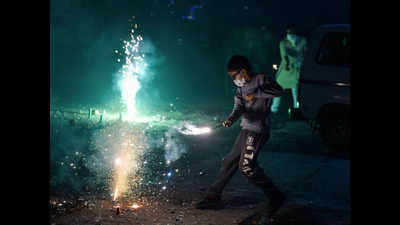- News
- City News
- delhi News
- Air pollution: Delhi's AQI post-Diwali 642, almost double 2017's 367
Trending
This story is from November 8, 2018
Air pollution: Delhi's AQI post-Diwali 642, almost double 2017's 367
Delhi's pollution level post-Diwali nearly doubled in comparison to last year as people burst firecrackers before and after the Supreme Court stipulated time frame of 8 pm to 10 pm.

A boy wearing pollution mask burns crackers during Diwali celebrations, in New Delhi, on Wednesday. PTI Photo
Key Highlights
- The overall air quality index (AQI) Thursday was recorded in the "severe plus emergency" category at 642.
- On Thursday, the PM2.5 level was recorded more than eight times the permissable limit at 492 µgm-3.
- The PM10 level was recorded six times the permissable limit at 618 µgm-3, according to SAFAR.
NEW DELHI: Delhi's pollution level post-Diwali nearly doubled in comparison to last year as people burst firecrackers before and after the Supreme Court stipulated time frame of 8 pm to 10 pm.

Inspite of the Supreme Court ban, people burst firecrackers during Diwali festival at Krishna Nagar in East Delhi on Wednesday night. TOI Photo
The overall air quality index (AQI) Thursday was recorded in the "severe plus emergency" category at 642, according to Centre-run System of Air Quality and Weather Forecasting and Research (SAFAR) data.
In 2017, the AQI was recorded at 367, a day after Diwali, while in 2016 it was 425. The AQI this year was over 1.7 times that of 2017.

AFTER DIWALI: Polythene bags and puja material dumped near the Yamuna river bridge in Delhi on Thursday. TOI Photo
A "severe plus emergency" AQI essentially means that even healthy people may suffer from respiratory illnesses on prolonged exposure. This air will seriously affect those with ailments, according to a SAFAR advisory.
On Thursday, the PM2.5 (particles in the air with a diameter of less than 2.5 micrometres) level was recorded more than eight times the permissable limit at 492 µgm-3.
The PM10 (particles in the air with a diameter of less than 10 micrometres) level was recorded six times the permissable limit at 618 µgm-3, according to SAFAR.
In 2017, official data showed the PM10 level reached 595 µgm-3 and PM2.5 was 407 µgm-3. India's official permissible PM2.5 limit is 60 µgm-3 while PM10 level is 100 µgm-3.
The sharp spike in pollution is caused by rampant burning of firecrackers that has led to the formation of a smoky layer across the national capital and drastically reduced visibility, authorities said.
The SAFAR had warned that even if partial toxic firecrackers as compared to last year were burnt, then the air quality would fall in the "severe" category.
The Supreme Court had allowed people to burst firecrackers from 8 pm to 10 pm only on Diwali and other festivals. The top court also allowed manufacture and sale of just "green crackers" which have low emission of light, sound and harmful chemicals.
It had said police should ensure that there was no sale of banned firecrackers and in case of any violation, the station house officer (SHO) of the police station of the area would be held personally liable and this would amount to committing contempt of the court.
In certain places firecrackers were burnt before and after the set time frame, despite the Supreme Court's order.
The areas where the violations were recorded included Mayur Vihar Extension, Lajpat Nagar, Lutyens' Delhi, IP extension, Dwarka and Noida Sector 78.

Inspite of the Supreme Court ban, people burst firecrackers during Diwali festival at Krishna Nagar in East Delhi on Wednesday night. TOI Photo
The overall air quality index (AQI) Thursday was recorded in the "severe plus emergency" category at 642, according to Centre-run System of Air Quality and Weather Forecasting and Research (SAFAR) data.
In 2017, the AQI was recorded at 367, a day after Diwali, while in 2016 it was 425. The AQI this year was over 1.7 times that of 2017.

AFTER DIWALI: Polythene bags and puja material dumped near the Yamuna river bridge in Delhi on Thursday. TOI Photo
A "severe plus emergency" AQI essentially means that even healthy people may suffer from respiratory illnesses on prolonged exposure. This air will seriously affect those with ailments, according to a SAFAR advisory.
On Thursday, the PM2.5 (particles in the air with a diameter of less than 2.5 micrometres) level was recorded more than eight times the permissable limit at 492 µgm-3.
The PM10 (particles in the air with a diameter of less than 10 micrometres) level was recorded six times the permissable limit at 618 µgm-3, according to SAFAR.
In 2017, official data showed the PM10 level reached 595 µgm-3 and PM2.5 was 407 µgm-3. India's official permissible PM2.5 limit is 60 µgm-3 while PM10 level is 100 µgm-3.
The sharp spike in pollution is caused by rampant burning of firecrackers that has led to the formation of a smoky layer across the national capital and drastically reduced visibility, authorities said.
The SAFAR had warned that even if partial toxic firecrackers as compared to last year were burnt, then the air quality would fall in the "severe" category.
The Supreme Court had allowed people to burst firecrackers from 8 pm to 10 pm only on Diwali and other festivals. The top court also allowed manufacture and sale of just "green crackers" which have low emission of light, sound and harmful chemicals.
It had said police should ensure that there was no sale of banned firecrackers and in case of any violation, the station house officer (SHO) of the police station of the area would be held personally liable and this would amount to committing contempt of the court.
In certain places firecrackers were burnt before and after the set time frame, despite the Supreme Court's order.
The areas where the violations were recorded included Mayur Vihar Extension, Lajpat Nagar, Lutyens' Delhi, IP extension, Dwarka and Noida Sector 78.
End of Article
FOLLOW US ON SOCIAL MEDIA










